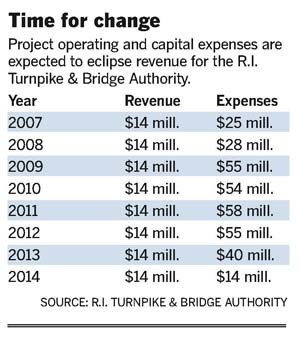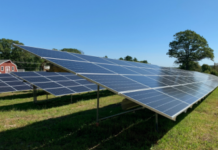The state agency that oversees the state’s two suspension bridges says it may be forced to raise tolls on the Pell Bridge – and reinstate them on the Mount Hope Bridge – to cover a projected $223 million budget shortfall over the next 20 years.
A study commissioned by the R.I. Turnpike & Bridge Authority and released Dec. 12 (READ MORE) found that the authority isn’t making enough money from its tolls to pay for costly repairs needed in the coming years to keep the aging bridges safe.
David Darlington, the authority’s chairman, said consultants examined the possibility of selling the bridges or convincing state legislators to subsidize the shortfall. But so far, the authority hasn’t received a serious purchase offer. And considering the state already has a gaping budget deficit, “they’re not going to take over $14 million to $15 million in bridge costs each year,” Darlington said.
Toll increases aren’t a foregone conclusion, either.
While the authority’s board of directors has the power to hike the charges, Darlington said that the panel will outline the study’s findings in a series of public forums next month.
“We want to hear from the public about what the impact is going to be,” he said.
The study by PB Americas, a New York-based engineering consultant, was conducted well in advance of a finance crisis so decisions on how to handle the shortfall could be made without duress, according to officials. “We have time – we’re doing this well before we’re broke,” Darlington said. “But things are going to need to change.”
In one scenario, annual toll increase of 25 cents per trip for token users to 50 cents per trip for others motorists over five years at the Pell Bridge would bring in an added $149 million over 20 years, according to the study.
From the day the Pell Bridge – which for years was named the Newport Bridge – opened in 1969, the price to cross has remained unchanged: $2 a car if paying by cash, less for those using tokens.
The authority has been able to avoid a toll hike because for many years a steady increase in traffic boosted revenues. But since 2002, the number of vehicles crossing has remained flat at about 10 million cars annually.
Officials said the authority’s annual income has remained at about $14 million in recent years – about $12 million from tolls and another $2 million in interest income from a $24 million renewal and replacement fund. The authority was so strapped for maintenance and repair money that it raided that fund of about $7 million this year, reducing future interest income.
To make ends meet, the authority also has deferred some of the more costly repairs on both the Pell and Mount Hope bridges. Even if the authority maintains its less aggressive 20-year repair plan, the deficit will total $111 million by 2027.
But Darlington said bridge safety could be an issue if the authority continues to delay repairs. Consultants say about $100 million worth of key maintenance work is not included in the current 20-year plan.
Although the turnpike authority oversees maintenance of the 78-year-old Mount Hope Bridge, which links Bristol and Portsmouth, it shut down the toll booths there in 1998.
The closure came after the disclosure that the booths were taking in $400,000 annually but were costing the authority $800,000 in personnel and building maintenance. Since toll collection ended, however, maintenance costs continued to rise. For example, the repainting and steel replacement on one of the bridge towers cost $14 million last year, officials said.
“The discussion shouldn’t have been about closing the toll booths, it should have been about increasing the tolls,” Darlington said.
Because there has been no revenue from the Mount Hope Bridge, motorists paying Pell Bridge tolls are essentially also footing the expenses at the Mount Hope Bridge, Darlington said.
Officials estimate that adding tolls to the Mount Hope Bridge will bring in $91 million over the next 20 years. But Darlington said he is particularly interested in hearing what impact those tolls would have on nearby businesses and residents.
The PB Americas study also considered the following revenue-generating options:
• Eliminating the free token discount given to those who travel over the Pell Bridge regularly. Added revenue: $17 million over 20 years.
• Establishing seasonal tolling with higher charges during the tourist season. Added revenue: $21 million over 20 years.
• Increasing commercial tolls. Added revenue: $10 million.
Other moves under consideration: selling advertising space at the toll plaza in Jamestown, leasing space on Pell Bridge for telecommunication lines and cellular phone antennae and outsourcing some operation and maintenance duties. The study did not provide revenue estimates on those three options. •
– With reports by Susan A. Baird
No posts to display
Sign in
Welcome! Log into your account
Forgot your password? Get help
Privacy Policy
Password recovery
Recover your password
A password will be e-mailed to you.













